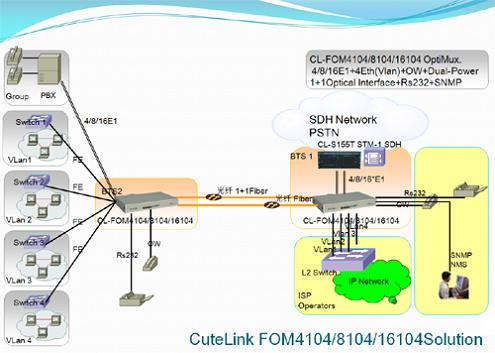How to work of Fiber Modem PDH multiplexer
A PDH fiber link consists of two fibers, one for data in each direction, and a terminal station at each end to drive light into one fiber, and detect it from the other, whilst sending and receiving data to nearby equipment with electrical signals. If the link is more than about 50 km long, then regenerator stations must be installed, to detect the light from the fiber on the first leg of the link, recover the data bits and use this to modulate a laser to drive the second leg.
PDH systems are point-to-point, bi-directional digital data links at rates of up to 2 Megabits per second. With careful monitoring - especially of the laser-diodes, which have limited life spans - they are generally highly reliable and form much of the inter-exchange, inter-capitals, and submarine cable networks now in use.
A single PDH link might carry 2/4/8/16/32 Mb/s (Megabits per second). All these streams must be synchronized - the presentation of bits in all the streams must be exactly in step
Key features of PDH
1. Fiber optical module
- Single fiber WDM option: the benefits and overall savings on a single-strand versus dual strand fiber implementation can be considerable, including not just the cost of fiber itself but also the labor and material involved.
- Multimode or single mode: the optical interfaces are available in wavelength of 850 nm, 1310nm and 1550nm in different performance levels. So, for instance, distances up to 120 km can be bridged by single mode optical fiber connection. 850nm for use with multimode fiber, 1310 nm for use with multimode fiber, 1310 nm or 1550 nm laser for extended range over single mode fiber.
- Optional secondary link provides automatic backup: using automatic switchover upon link failure when fiber is broken or destroyed by some construction. It is impossible that the optical module doesn’t work or fail, since MTBF of each optical module ex-factory is 15 years or 200 thousand hours. They are stable and applied for large scale. So this functionality is only used for the failure of fiber. Slide-in and hot swap second optical module is useless for a matured PDH optical multiplexer besides adding the possibility of optical module failure. Most of well known manufacturing has two versions. One is for increased competitiveness in application where redundancy is not needed. The other is for high cost requirement to avoid fiber failure not module failure.
2 E1 interface
- G.703: G.703 is the electrical and functional description. Any E1 interface can be conformed with G.703
- G.823:
- G.724:
It is required to conform with these three protocols. Regarding the connector of E1 interface, there are differenttypes (such as BNC in Southeast Asia, CC3 and BNC in China, RJ45 balanced in Europe). So every manufacturing will provide the connector for themselves. Any customer doesn’t be worried for the connectors. They are only
accessories for PDH multiplexer, not key features.
3 Management
- RS232 terminal: it is possible to login by means of a PC through an RS232 interface and a respective terminal program. Via RS232 interface the user can activate certain test functions on site, edit current status information of list a fault journal.
- SNMP application: allows to monitor PDH multiplexer. Modular PDH optical multiplexer has a standard RJ45 interface in the agent that provides for connection to existing LAN environment.
- JAVA based (X.86) and UNIX based
- CORBA northbound interface: for interfacing between various management layers, CORBA was adopted by the TMN framework. CORBA allows for interconnectivity and communication across heterogeneous operating systems and telecommunication networks. CORBA supplies a software interface defining data models to be used between various management layers. CORBA supports multi-vendor distributed network management applications, providing the data interface between clients and servers, and between systems of different vendors and a common upper layer NMS or OSS.
- Integrated to HP-OV
4 Power supply
- AC: 100~240v
- DC: -48v, 24v, -24v
- Optional redundant power supply: provides power redundancy and fail-safe operation.
5 EMC (electromagnetic compatibility) protection
- Module: there is electromagnetic protective layer in every modular front panel to avoid electromagnetism to leak.
- Standalone: there is electromagnetic protective net between PCB card and power supply.
Application solution
Voice service and leased line for data service Provides legacy voice service and data service with the leased line for the company. In the early of data service, DDN is applied in the all data service field. But with the development of customer requirements (such as bank, finance, school, enterprise and so on), bandwidth isn’t satisfied with the need. So PDH come to another high tide with substitution of legacy base modem to provide more bandwidth with fiber access for leased line data service.

The evolution of PDH
As Internet is booming, the legacy PDH optical multiplexer is developed to allow for connection of fast Ethernet as well as E1 lines operating independently one another. Thus up to 120 telephone calls can be transmitted simultaneously and optimum use can be made of the existing optical fiber. The fast Ethernet + 4E1 operates on LAN
side in the same way as a full duplex switch. The multiplexers can handle over length Ethernet frame (1522 Bytes) according to IEEE 802.1Q and supports VLAN tagging.

